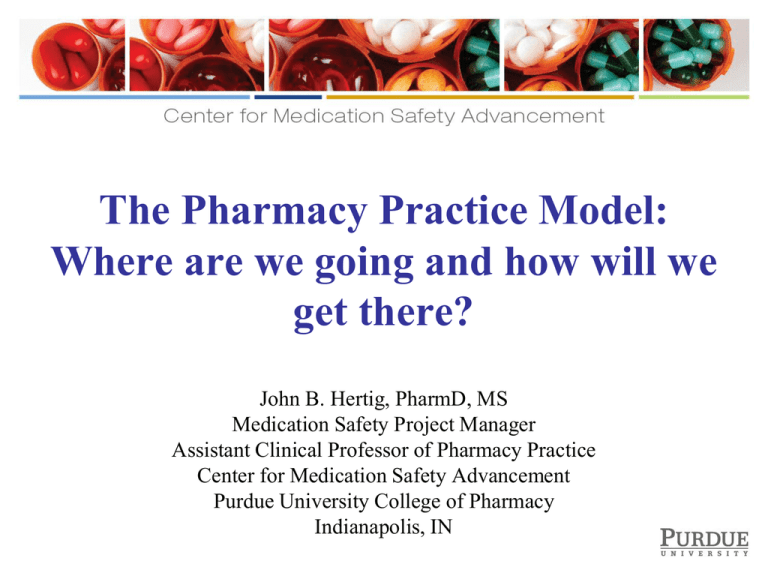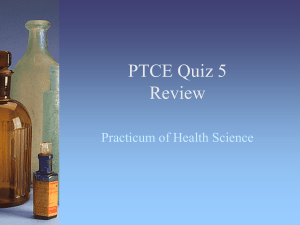Resource - Indiana Rural Health Association
advertisement

The Pharmacy Practice Model: Where are we going and how will we get there? John B. Hertig, PharmD, MS Medication Safety Project Manager Assistant Clinical Professor of Pharmacy Practice Center for Medication Safety Advancement Purdue University College of Pharmacy Indianapolis, IN Disclosure • Dr. John B. Hertig has no conflicts of interest to disclose. Learning Objectives • Understand the current climate of health professions’ practice model review and the role of the ASHP Pharmacy Practice Model Initiative in the Rural Hospital setting • Review the recommendations from the Pharmacy Practice Model Summit • Identify how pharmacy practice model change in rural hospitals supports improved quality, accountability, and patient outcomes, and how a multidisciplinary approach is key to success Outline • Background – why change? • About the Pharmacy Practice Model Initiative • Impact on rural hospitals • Next steps - summary First Things First • Who is in the audience? • What practice types do you represent? • How many of you have heard of the ASHP Pharmacy Practice Model Initiative? Background – Why Change? • Professions must continually assess their practice to determine whether expertise is being maximized – Healthcare reform – Quality and safety – Social and economic influences • Pharmacy practice changes – Doctor of Pharmacy degree – Residency training Why Change? • More patients, increased demand – Payment tied to performance – Move away from fee-for-service payments – Pressure to reduce costs, reward performance • Challenge to US health care system to improve quality and cost effective care – More quality, better reimbursement • Better Care! AJHP 2009;66:713 Factors Driving Practice Change • Drug therapy is becoming more complex with greater patient risk • Pharmacists recognized as: – drug therapy experts – medication use process experts • Patients are better served if pharmacists take an active role as part of the care team Why Pharmacists? Pharmacists • Moral, ethical and social obligations • Health system changes and opportunities • Rationale use of pharmacist resources • Impact of pharmacy technicians and technology • Value of pharmacists ASHP/ASHP Foundation Pharmacy Practice Model Objectives Pharmacists Technicians & Technology Pharmacists Educational Factors Driving Change http://www.aacp.org/Docs/MainNavigation/InstitutionalData/8921_DegreesConferred.pdf Educational Factors Driving Change Impact • All these factors have combined to drive critical discussions regarding change within the health-system pharmacy profession • But, where do we go from here? Pharmacy Practice Model Initiative (PPMI) • Launched and coordinated by ASHP and the ASHP Research and Education Foundation • The goal of this initiative is to significantly advance the health and well-being of patients – Develop and disseminate a futuristic practice model that supports the most effective use of pharmacists as direct patient care providers PPMI. Available at <www.ashp.org> The Purpose of the PPMI • Describes how pharmacy department resources are deployed to provide care • One size does not fit all • Does include: – How pharmacists practice and provide care to patients – How technicians are involved to support care – Use of automation/technology in the medication use system AJHP 2010;67:542 The Purpose of the PPMI • • • • • Create a framework Determine services Identify emerging technologies Develop a template Implement change PPMI. Available at <www.ashp.org> The Purpose of the PPMI • Create a Framework – Create a framework for a pharmacy practice models that ensure provision of safe, effective, efficient, accountable, and evidence-based care for all hospital/health system patients • Determine Services – Determine patient care-related services that should be consistently provided by departments of pharmacy in hospitals and health systems and increase demand for pharmacy services by patients/caregivers, healthcare professionals, healthcare executives, and payer PPMI. Available at <www.ashp.org> The Purpose of the PPMI • Identify Emerging Technologies – Identify the available technologies to support implementation of practice models, and identify emerging technologies that could impact the practice model • Develop a Template – Support the optimal utilization and deployment of hospital and health-system pharmacy resources through development of a template for practice models that are operational, practical, and measurable • Implement Change – Identify specific actions pharmacy leaders and staff should take to implement practice model change including determination of the necessary staff (pharmacy leaders, pharmacists, and technicians) skills and competencies required to implement this model) PPMI. Available at <www.ashp.org> Types of Models • Drug-distribution centered model – defined as “mostly distributive pharmacy with limited clinical services” • Patient-centered integrated model – defined as a “clinical generalist model with limited differentiation of roles” – nearly all pharmacists have distributive and clinical responsibilities • Clinical-specialist-centered model – defined as “separate distributive and clinical specialist roles” Major PPMI Themes • Move pharmacists closer to the patient – Multidisciplinary care • Responsibility for safe use of medications and ensuring quality • Well-developed technician workforce • Wide-spread use of technology Considerations for the Rural Hospital • Rural hospitals face unique challenges in implementing new and innovative practice models • “The capacity of 1” – How much can we do with limited resources? – Where do our priorities lie? • Ensuring we practice at “the top of our license” • Teamwork among all professions is essential! Beyond the Rhetoric Rural Health Today –Current State • Pharmacy in rural health settings differs from larger settings – Limited personnel – Limited hours of operation – Limited technology • But, boundless opportunity! – Need to be strategic on how to adapt principles of PPMI to rural settings • But first…where are we now? Rural Hospital Practice Models AJHP 2010;67:542 AJHP 2010;67:542 Where Are We Going? • PPMI Summit – November 2010 • Summit recommendations and voting record published February 2011 – Lists all consensus pharmacy services that all patients have the right to receive – Outlines requirements of pharmacy departments – Reviews barriers to improvement • Rural Hospitals were represented at the Summit, but many recommendations still pose challenges to small institutions – Let’s review a few The PPMI Summit http://www.ashp.org/DocLibrary/PPMI/Summit-Recommendations.aspx Imperatives for New Pharmacy Practice Models • There is opportunity to significantly advance the health and well being of patients in hospitals/health systems by changing how pharmacists, pharmacy technicians, and technology resources are deployed Vote 100% Imperatives for New Pharmacy Practice Models • In the next 5-10 years, hospital/health system executives and medical staff leaders will expect pharmacists to help ensure compliance with quality-ofcare standards Vote 93% Optimal Pharmacy Practice Models: Certifications • Pharmacists who provide drug therapy management should be certified through the most appropriate Board of Pharmacy Specialties board certification process. Vote 82% Pharmacy Technicians • All distributive functions that do not require clinical judgment should be assigned to technicians. Vote 93% Additional Recommendations Every pharmacy department should: • • • • • • B24a. Identify drug therapy management services that should be provided consistently by its pharmacists B24b. Develop a plan to reallocate resources to devote significantly more pharmacist time to drug therapy management services B24c. Develop a plan to allocate pharmacy student time to drug therapy management services B24d. Develop, maintain, and update medication-use policies B24e. Ensure institutional safe medication use B24f. Play a critical role in ensuring that the hospital or health system adheres to medication-related national quality indicators • • • • • • • B24g. Play a critical role in ensuring that the hospital or health system adheres to medication-related evidence-based practice guidelines B24h. Track and trend adverse drug events in the hospital or health system B24i. Manage prospective medication-use evaluation programs to improve prescribing B24j. Manage retrospective medicationuse evaluation programs to improve prescribing. B24k. Identify problem-prone and highrisk therapies using pre-established criteria B24l. Routinely review hospital or healthsystem antibiotic resistance patterns B24m. Track and trend pharmacist interventions Am J Health-Syst Pharm. 2011. 68:1148 Moving Forward Make Providing Pharmacy Cognitive Services a Priority • Drug distribution is still essential • Increased pharmacist contact with providers and patients have evidence-based benefits – Lower costs – Higher quality and safety – Improved patient satisfaction • Expand the role of technicians – Consider additional training and responsibilities for technicians – Use technicians in non-traditional roles • Technology Technology • Technology can help move the pharmacist closer to the patient without compromising quality – Automated dispensing cabinets – Barcode systems – Remote verification and order-entry • Improves access to information for all health professionals – Improved timeliness of care – Retrievable information for quality improvement • Increases safety and quality Teamwork • Healthcare is a team sport – Advancing pharmacy practice takes acceptance and dedication by the entire team • Work together to develop standard processes, protocols, and policies that support improved pharmacy services • Continuous feedback and improvement • Develop a care model that places the patient at the center Considerations for Rural Hospitals • Leadership support is crucial • Multidisciplinary collaboration – Don’t go it alone • Remember scope! – Select those pharmacy services that your institution deems absolutely critical; make those a priority – Small wins • It’s a journey – Continually evaluate your direction and progress – Small tests of change Summary • The health-system pharmacy profession is undergoing a major practice model evaluation – Goal is to improve medication use – Improve patient care • Rural hospitals are a key part of this effort • Use PPMI recommendations to develop focused improvement efforts • Limited resources can still make a large impact for our patients! Questions? The Pharmacy Practice Model: Where are we going and how will we get there? John B. Hertig, PharmD, MS Medication Safety Project Manager Assistant Clinical Professor of Pharmacy Practice Center for Medication Safety Advancement Purdue University College of Pharmacy Indianapolis, IN






